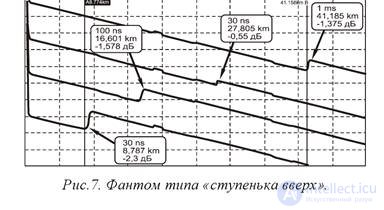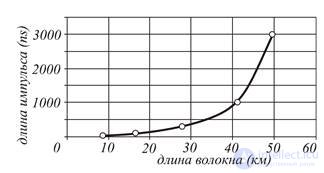Это окончание невероятной информации про лазер.
...
phantom appears, it is recommended to add a drop of immersion liquid to the junction of the coil with the line.
Phantom "Peak". This phantom is detected when measuring a BOJIC length of up to 70 km with a Wavetek Hellion reflectometer. It looks like a phantom peak, jumping up and down. It is extremely rare, the reason for its appearance is still unknown (possibly due to reflection from the end of the line). Cases of the disappearance of this phantom when bending the end or wetting the connector with an immersion liquid have been observed.
Phantom "Step up". It is observed quite rarely. For the first time, we have seen in the area 168.096 km long, on one fiber out of 16, when measuring HP Е6008 (Fig.7). The phantom is characterized by a supernaturally large amplitude - up to -2.3 dB - and appears at different distances, depending on the pulse length (see Fig.7 and Fig.8). When the “Step Up” phantom appears, it is recommended to measure at other pulse lengths or repeat the measurement with another device.
| |
|
|
|
| |
 |
| |
|
 |
| |
Thus, it is clear that many problems arise due to the use in the measurement of probe pulses with a fixed duration. Therefore, it seems promising to develop reflectometers with automatically changing probe pulses, which will allow, by fitting reflectograms at different pulse durations, to get rid of both “dead zones” and “noisiness” of remote areas, as well as help identify phantoms like “Peak” and “Step up” ". Along with this, it is necessary to create an algorithm for processing reflectograms, which would remove phantoms moving along the length of the fiber when the duration of the pulses changes, from the resulting trace. Automatic removal of the mirror twin phantom is also necessary.
Software tools available in real samples of reflectometers for processing the results of probing are far from perfect and therefore are practically not used in practice. This is due, for example, to inaccurate determination of the location of welded joints, omission of joints with “zero” attenuation, as well as inaccurate determination of the attenuation value itself. The so-called method of bilateral analysis of reflectograms cannot be considered effective. Therefore, the improvement of programs for processing reflectograms and algorithms for the operation of such devices seems to be a promising and relevant activity.
The development of the new principles of diagnostics and testing by BOJIC does not lose its relevance, but, on the contrary, is becoming more and more practical. The tasks of detecting non-localized defects and controlling mechanical-thermal stresses in the fiber are put in the forefront. Recently, new devices have been proposed that work on the principle of registration of Brillian scattering [8]. Brüllien reflectometers (BOTDR), unlike their usual predecessors, will allow to determine the fiber tension depending on the fiber length. With their help, it will be possible to identify areas with increased tension that require replacement due to an increased risk of microcracks. It should also be noted that currently, only temporal modulation of the optical signal is used to diagnose fiber-optic channels, which does not allow obtaining information on the state of the substance over the fiber section. The use of spatial modulation of radiation introduced into the fiber by means of diffractive optical elements — ideally tunable by control electrical pulses — would improve the quality of such measurements.
Along with fiber optic problems, there are common problems for fiber optics such as nonlinear effects in optical fibers. Nonlinear effects in an optical fiber are due to the nonlinear response of a substance to an increase in the intensity of the light flux. As a result, the optical characteristics of the medium (electronic polarizability, refractive index, absorption coefficient) become functions of the electric field intensity of the light wave, so that the polarization of the medium begins to depend nonlinearly on the field strength, and waves with different frequencies and directions of propagation influence each other. The main nonlinear phenomena characteristic of optical fibers: nonlinear refraction, stimulated scattering, and four-wave mixing. Nonlinear refraction is caused by the dependence of the refractive index of the fiber core (Kerr effect), and hence the phase of the output signal on the optical signal intensity. When the signal power is high enough, its collocations *** lead to phase self-modulation and phase cross-modulation (FCM). In the first case, the signal acts on itself, in the second - on the signal in another channel. Each of these effects can interfere with transmissions using phase shift keying. The maximum allowable value of channel power due to FSM and FCM is inversely proportional to the number of multiplexed channels. The nonlinearity of the refractive index in the dispersing medium of the fiber can lead to the formation of optical solitons. The use of optical solitons allows transmitting a signal over distances up to several thousand kilometers without distortion of the pulse shape, therefore communication lines using soliton transmission modes are promising, but today such systems are too expensive and do not find commercial use. Forced light scattering is scattering by elementary excitations of the medium induced by the scattered wave. Since the scattering process is stimulated by the scattered light itself, the scattered radiation is characterized by a high degree of coherence, narrow radiation patterns of individual components, and an intensity comparable to the intensity of the incident light. Thus, when a medium is excited by a powerful light source, its parameters are modulated, which leads to amplitude modulation of the scattered light and, consequently, to the appearance of new spectral components in it. The most important types of the phenomenon under consideration are: stimulated Raman scattering (WRC), also traditionally referred to as Raman anglophone sources, and Mandel'shtam-Brillouin stimulated scattering (SBS). SRS is associated with the excitation of new oscillatory and, to a lesser extent, rotational energy levels of particles of the medium, and SBS with the appearance of hypersonic waves in the medium. The effect of WRC is small (less than 1 dB per channel) and increases with the increase of the product of the total channel power and the difference between the frequencies of the extreme channels. In other words, this effect is significant only for systems with hundreds of channels. Unlike WRC, radiation scattered by the Mandel'shtam-Brillouin mechanism propagates only in the direction opposite to the incident one. Its intensity is significantly higher than with WRC. The effect of Mandel'shtam-Brillouin scattering depends on the transmission rate. With the growth of the latter, it decreases, and especially quickly when using phase manipulation. It can be neglected for pulses shorter than 10 ns. Four-wave mixing consists in the fact that in the presence of two waves with frequencies f1 and f2 (f1
Conclusion
It is currently difficult to find a field of science and technology where lasers would not be used. Generation was obtained for more than 1000 objects: crystals, activated glasses, liquids, semiconductors, plasma, gases. However, despite the well-known successes achieved in quantum electronics, in most cases the physical limits of the applicability of the basic principles underlying the operation of quantum devices have not yet been established. The limits of monochromaticity and coherence of the radiation and their connection with the power and frequency of the radiation are not clarified, it is not known how far one can go to the high-frequency region; what is the limiting value of efficiency when converting various forms of energy into coherent light, etc. By now, quantum generators have gone out of the field of academic research and have become the equipment of technical progress and instruments of scientific research. The development and improvement of quantum generators continues, new frequency ranges are mastered, the stability of all parameters is improved, power is increased.
In cases with fiber-optic systems, the data presented show that the task of creating reliable fiber-optic systems for telecommunication systems is still far from its final decision. The problems arising from the actual operation of the BOJIC require not only technological, but also fundamental research. A decisive contribution to the solution of these problems can be expected from the application of methods of computer and integrated micro-optics, which, in turn, can contribute to the development of new approaches in these areas of science and technology
Bibliography
1. Fedorov B.F. Lasers Basics of device and application "DOSAAF USSR", 1988.
2. Kondilenko I.I. Korotkov P.A. Khizhnyak A.I. Physics of lasers "Vysch school", 1984.
3. Zvelto O. Principles of Mir lasers, 1990.
4. Bayborodin Yu.V. Fundamentals of laser technology "Vysch school", 1988.
5. Boreysho A.S. Lasers - device and action 1992.
6. Dirac P.A.M. Principles of quantum mechanics "Fizmatlit", 1979.
7. Blokhintsev DI Principal issues of quantum mechanics. "Science", 1966
8. Internet
9. Kachmarek F. Introduction to the physics of lasers "Mir", 1981.
10. Grankin V.Ya. and others. Laser radiation "Voenizdat", 1977
10. Gribkovskiy V.P. The theory of absorption and emission of light in semiconductors,
Science and Technology ", 1975
11. Tarasov L.V. Lasers. Reality and hope "Science", 1985.
12. Muradyan AG, Goldfarb I.S., Inozemtsev V.P. Optical cables multichannel line of communication. Radio and Communications, 1987.
Principles of laser technology
The induced laser radiation in quantum devices is the result of transformed mechanical, chemical, electrical, ionic and molecular energy into induced radiation. Induced radiation is the result of the interaction of the inoculated induced radiation with excited particles of the active element of a laser, where ions, electrons and molecules are used as particles.
The interaction of particles is described by the laws of thermodynamics. At thermodynamic equilibrium, the distribution of particles is described by the Boltzmann law in which the degeneracy coefficients, which characterize the degree of quantum yield under the action of the excitation energy. The number of excited particles depends on the type of material.
Under certain conditions, the system is in the excited state and when the particles move from the upper level to the lower level, radiation occurs:.
To obtain the mode of induced radiation, it is necessary to create an inversion, that is, an excess of particles at a higher level, for which it is necessary to create an excitation energy. With induced excitation of the upper level will be greater than the lower, and their difference is called inversion
Conclusion: In thermodynamics, the system is balanced, that is, in a induced radiation otherwise.
To obtain induced radiation, it is necessary that all particles from the upper energy level simultaneously pass to the lower energy level with a certain probability.
Продолжение:
Часть 1 Principles of laser technology
Часть 2 - Principles of laser technology
Часть 3 Principles of laser technology - Principles of laser technology




Comments
To leave a comment
Quantum electronics
Terms: Quantum electronics